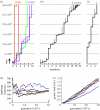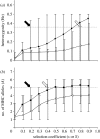A new theory of MHC evolution: beyond selection on the immune genes
- PMID: 18986972
- PMCID: PMC2660941
- DOI: 10.1098/rspb.2008.1299
A new theory of MHC evolution: beyond selection on the immune genes
Abstract
The major histocompatibility complex (MHC) is a dense region of immune genes with high levels of polymorphism, which are arranged in haplotype blocks. Traditional models of balancing selection (i.e. overdominance and negative frequency dependence) were developed to study the population genetics of single genes. However, the MHC is a multigene family surrounded by linked (non-neutral) polymorphisms, and not all of its features are well explained by these models. For example, (i) the high levels of polymorphism in small populations, (ii) the unexpectedly large genetic differentiation between populations, (iii) the shape of the allelic genealogy associated with trans-species evolution, and (iv) the close associations between particular MHC (human leucocyte antigen, HLA) haplotypes and the approximately 100 pathologies in humans. Here, I propose a new model of MHC evolution named Associative Balancing Complex evolution that can explain these phenomena. The model proposes that recessive deleterious mutations accumulate as a 'sheltered load' nearby MHC genes. These mutations can accumulate because (i) they are rarely expressed as homozygotes given the high MHC gene diversity and (ii) purifying selection is inefficient with low recombination rates (cf. Muller's ratchet). Once fixed, these mutations add to balancing selection and further reinforce linkage through epistatic selection against recombinants.
Figures




Similar articles
-
Trans-species polymorphism, HLA-disease associations and the evolution of the MHC.Commun Integr Biol. 2009 Sep;2(5):408-10. doi: 10.4161/cib.2.5.8765. Commun Integr Biol. 2009. PMID: 19907702 Free PMC article.
-
Excess of Deleterious Mutations around HLA Genes Reveals Evolutionary Cost of Balancing Selection.Mol Biol Evol. 2016 Oct;33(10):2555-64. doi: 10.1093/molbev/msw127. Epub 2016 Jun 28. Mol Biol Evol. 2016. PMID: 27436009 Free PMC article.
-
High polymorphism in MHC-DRB genes in golden snub-nosed monkeys reveals balancing selection in small, isolated populations.BMC Evol Biol. 2018 Mar 13;18(1):29. doi: 10.1186/s12862-018-1148-7. BMC Evol Biol. 2018. PMID: 29534675 Free PMC article.
-
Advances in the Evolutionary Understanding of MHC Polymorphism.Trends Genet. 2020 Apr;36(4):298-311. doi: 10.1016/j.tig.2020.01.008. Epub 2020 Feb 7. Trends Genet. 2020. PMID: 32044115 Review.
-
Evolution of the mammalian MHC: natural selection, recombination, and convergent evolution.Immunol Rev. 1999 Feb;167:45-58. doi: 10.1111/j.1600-065x.1999.tb01381.x. Immunol Rev. 1999. PMID: 10319250 Review.
Cited by
-
Allelic diversity and patterns of selection at the major histocompatibility complex class I and II loci in a threatened shorebird, the Snowy Plover (Charadrius nivosus).BMC Evol Biol. 2020 Sep 10;20(1):114. doi: 10.1186/s12862-020-01676-7. BMC Evol Biol. 2020. PMID: 32912143 Free PMC article.
-
Intronic primers reveal unexpectedly high major histocompatibility complex diversity in Antarctic fur seals.Sci Rep. 2022 Oct 26;12(1):17933. doi: 10.1038/s41598-022-21658-7. Sci Rep. 2022. PMID: 36289307 Free PMC article.
-
Microsatellite and major histocompatibility complex variation in an endangered rattlesnake, the Eastern Massasauga (Sistrurus catenatus).Ecol Evol. 2016 May 17;6(12):3991-4003. doi: 10.1002/ece3.2159. eCollection 2016 Jun. Ecol Evol. 2016. PMID: 27516858 Free PMC article.
-
Human leukocyte antigen super-locus: nexus of genomic supergenes, SNPs, indels, transcripts, and haplotypes.Hum Genome Var. 2022 Dec 21;9(1):49. doi: 10.1038/s41439-022-00226-5. Hum Genome Var. 2022. PMID: 36543786 Free PMC article. Review.
-
The sheltered genetic load linked to the s locus in plants: new insights from theoretical and empirical approaches in sporophytic self-incompatibility.Genetics. 2009 Nov;183(3):1105-18. doi: 10.1534/genetics.109.102707. Epub 2009 Sep 14. Genetics. 2009. PMID: 19752218 Free PMC article.
References
-
- Aguilar A., Roemer G., Debenham S., Binns M., Garcelon D., Wayne R.K. High MHC diversity maintained by balancing selection in an otherwise genetically monomorphic mammal. Proc. Natl Acad. Sci. USA. 2004;101:3490–3494. doi:10.1073/pnas.0306582101 - DOI - PMC - PubMed
-
- Bell G. University of California Press; Berkeley, CA: 1982. The masterpiece of nature: the evolution and genetics of sexuality.
-
- Bernatchez L., Landry C. MHC studies in nonmodel vertebrates: what have we learned about natural selection in 15 years? J. Evol. Biol. 2003;16:363–377. doi:10.1046/j.1420-9101.2003.00531.x - DOI - PubMed
-
- Bos D.H., Waldman B. Evolution by recombination and transspecies polymorphism in the MHC class I gene of Xenopus laevis. Mol. Biol. Evol. 2006;23:137–143. doi:10.1093/molbev/msj016 - DOI - PubMed
-
- Charlesworth D., Kamau E., Hagenblad J., Tang C.L. Trans-specificity at loci near the self-incompatibility loci in Arabidopsis. Genetics. 2006;172:2699–2704. doi:10.1534/genetics.105.051938 - DOI - PMC - PubMed
MeSH terms
LinkOut - more resources
Full Text Sources
Research Materials

